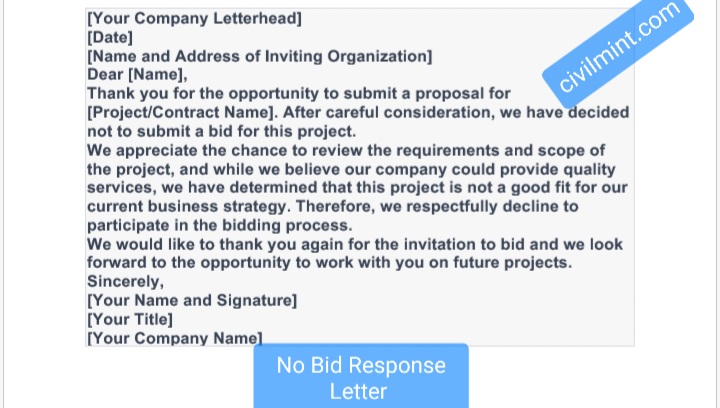Table of Contents
What Is No Bid Letter?
A no-bid letter is a formal letter issued by a client to inform a contractor that their proposal or bid for a project has not been accepted. This letter is usually sent after a bidding process, and it informs the supplier that their bid was not selected, often due to factors such as cost, technical feasibility, experience, or not meeting other requirements.
Other names of No-Bid Letter are no-bid decision letter, RFP declination letter, IFB declination letter, no-bid notice, intent to no-bid letter, no-bid response.
A no-bid letter is an important communication tool that helps maintain transparency and accountability in the procurement process. This provides the supplier with a clear understanding of why their bid was rejected, and it allows them to review their proposal and make improvements for future opportunities. In order to be potentially included in future opportunities, the provider should mention the reasons for declining such invitation in the no-bid notice.
A no-bid letter may also be issued when a company decides not to pursue a project or opportunity for other reasons, such as a change in strategic direction or budget constraints.
Before writing a no-bid letter, client must decide not to bid. This decision is the result of an analytical process, the bid/no-bid analysis, also known as the bid/no-bid decision process.
Bid/No Bid Analysis
A bid/no-bid analysis is a crucial process for companies considering whether to bid on a contract opportunity or not. This analysis helps companies evaluate the potential risks and rewards of submitting a bid proposal. The analysis is typically conducted using a bid/no-bid checklist that contains a series of relevant questions to assess the suitability of the opportunity for the company.
The checklist helps in identifying the potential risks and opportunities, including the company’s capability to meet the requirements, the potential profitability, the available resources, the competition level, and any other factors that might impact the success of the bid. By answering these questions, the company can evaluate whether the opportunity aligns with its business objectives and if it is worth pursuing.
Based on the results of the bid/no-bid analysis, the company will determine whether to submit a proposal or not. If the decision is to bid, the company will send a letter of intent to the purchasing officer, indicating its interest in the opportunity. If the decision is not to bid, a no-bid letter will be sent, explaining the reasons for not pursuing the opportunity.
The bid/no-bid analysis helps the company to make informed decisions and avoid unnecessary expenses, as well as ensuring that it only pursues opportunities that align with its business objectives and capabilities. The analysis also provides an opportunity to identify areas for improvement, which can be addressed to improve the company’s future bidding success.
Example Of No Bid Letter

No Bid Letter Response
A “No Bid Letter Response” is a formal letter sent by a company or individual who has been invited to submit a proposal for a project or contract, but has decided not to submit a bid. This letter is typically sent to the company or organization that issued the invitation to bid, and it explains the reasons why the bidder is declining to participate in the bidding process.
Here is a sample No Bid Letter Response:

